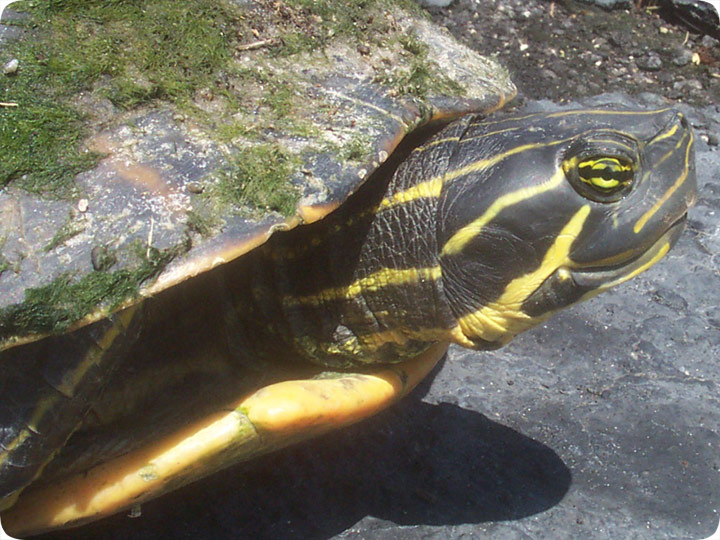-
info@aaanimalcontrol.com
Call us for help in your town
Humane Wildlife Education
Florida Redbelly Turtle

I didn't see any good habitat areas on the condo property, but the turtle must have come from somewhere and was going somewhere. My research indicates that it can live in fresh and brackish water. Both types of water exist near the area.
It's a herbivorous turtle. As you can see, the shell is covered largely in plant matter. I don't think it had been far from home for long. It's possible that the animal was looking for a place to lay eggs. These turtles usually lay eggs in sand, sometimes in the nests of alligator eggs.
On the premise that the turtle might be lost or stuck in the fenced-in condo area, I was tempted to move it to a new habitat. However, I think that intervention is usually a mistake. Somehow, mysteriously, wildlife knows what it is doing. I believe that it is usually more harmful than good to interfere. Of course, interfering with wildlife is my job, so I guess I don't have much of a right to say anything.
Do it yourself: Visit my How To Solve Conflicts with Wildlife page for tips and advice.
Get professional help: Visit my Nationwide Pro Directory of wildlife removal experts.
The Redbelly Turtle is one of the most popular turtles in North America and lives from the southern US down to northern Mexico. The Red belly Turtle has a long and oval shell. The top of the shell can be olive and black in color. The bottom of the shell is a yellow color. The skin of a turtle is the same color as its top shell. It has webbed feet and these webbed feet help them swim. They are the cutest turtles of all the turtles. They can make good pets as well.
The Red belly Turtle hunts for its food along the bottom of lakes and rivers. It will stir up the bottom and then pursues any creatures it was able to scare away. It will tear away at large prey by holding it in its mouth and tearing it up with its back feet. It will eat different plants on the bottom of the water as well. It will skim the surface and with its mouth wide open, it will catch food particles that way. There are three different species of the Rebelly Turtle but they do pretty much eat the same things.
The Redbelly Turtle does not have many predators because its shell does protect them. However, raccoons have been known to eat them and their young are very vulnerable to predators because of their soft shells. Of course, a lot of different predators will go after their eggs. The main predators of a young Red belly Turtle and its eggs are snakes, crows, squirrels, rats, muskrats and weasels.
A Redbelly Turtle is a reptile. You will often see them basking in the sun to warm itself up. Then it will go back into the water and begin to forage for food. Whenever it feels chilled, it will come out of the water and return to the sun to warm up. During the night, it will go down underneath the water or it will sleep on an object underneath the water.
A Red belly Turtle will mate in the water in the spring or fall. The female can store sperm that she will use on up to three different clutches. Sperm can be okay to use for up to three years. The females are the ones that prepare the nest and lay the eggs. She will dig herself a hole in the sand and she will often choose a spot that faces south. She will urinate on the eggs to pack down the sand. The eggs are usually laid in sand away from the water’s edge. The eggs are incubated for a period of 72 to 80 days. Once the eggs are laid the mother does not sit with them and she does not care for them either. They are on their own to fend for themselves. The young in some species will stay in the nest until spring and others will make their way to the water. Some areas have designated turtle crossings for the young ones and there are people who will stop and pick up the young ones and deliver them to the edge of the water to help them out.
For more wildlife stories, click my Wildlife Blog or click my below banner to hire a local trapper.





















